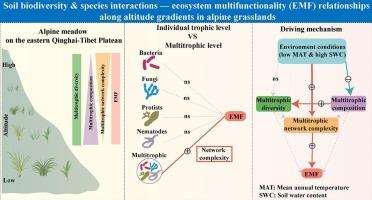Soil multitrophic network complexity drives positively ecosystem multifunctionality along altitude gradients in alpine grasslands
IF 5.7
1区 农林科学
Q1 GEOSCIENCES, MULTIDISCIPLINARY
引用次数: 0
Abstract
Soil biodiversity is essential for ecosystem multifunctionality (EMF). However, the relative contributions of soil biodiversity and biological interactions to EMF across multiple trophic levels, and the potential mechanisms remain uncertain under environmental variability, especially in fragile and highly heterogeneous alpine grasslands. Here, we investigated biodiversity (e.g., species diversity and community composition) and their interactions (quantified by network complexity) of individual soil trophic groups (bacteria, fungi, protists and nematodes) and multitrophic level with EMF (quantified using 18 variables) along altitude gradients (3400–4100 m) in alpine meadow on the eastern Qinghai-Tibet Plateau. The results showed that individual trophic biodiversity and network complexity had distinct patterns along altitude. At multitrophic level, although species diversity remained relatively stable, and community composition dissimilarity decreased, the network complexity increased with increasing altitude. EMF remained stable along altitude. No significant relationships between EMF and soil biodiversity were found at individual trophic and multitrophic levels. In contrast, EMF was positively correlated with multitrophic network complexity, and this positive association was strengthened with increasing altitude, although it was not correlated with network complexity of individual trophic groups. Further pathways analysis indicated that multitrophic biodiversity had no significant effect on multitrophic network complexity and EMF. However, environmental conditions (low temperature and high soil moisture, which are prevalent at higher altitudes) enhanced multitrophic network complexity, with high soil moisture in particular facilitating bacterial-fungal synergism, thereby positively driving EMF along altitude gradients. This study highlighted the crucial role of soil multitrophic interactions in supporting EMF in alpine grasslands. These results could offer insight into soil biodiversity-EMF relationship and theoretical basis for conservation and management of alpine grasslands.

土壤多营养网络复杂性对高寒草原生态系统多功能性具有正向驱动作用
土壤生物多样性是生态系统多功能性的基础。然而,土壤生物多样性和生物相互作用在多个营养水平上对EMF的相对贡献及其潜在机制在环境变异性下仍不确定,特别是在脆弱和高度异质性的高寒草地中。研究结果表明,各海拔高度的个体营养多样性和网络复杂性具有明显的分布规律。在多营养水平上,虽然物种多样性保持相对稳定,群落组成差异减小,但网络复杂性随着海拔的升高而增加。电磁场沿高度保持稳定。电磁场与土壤生物多样性在个体营养和多营养水平上均无显著关系。相反,EMF与多营养网络复杂性呈正相关,且随海拔的升高而增强,但与单个营养类群的网络复杂性不相关。进一步的路径分析表明,多营养生物多样性对多营养网络复杂性和EMF没有显著影响。然而,环境条件(在高海拔地区普遍存在的低温和高土壤湿度)增强了多营养网络的复杂性,高土壤湿度尤其有利于细菌-真菌协同作用,从而沿着海拔梯度积极推动EMF。本研究强调了土壤多营养相互作用对高寒草地电磁场的支持作用。研究结果可为深入了解土壤生物多样性与emf的关系提供理论依据,并为高寒草原的保护与管理提供理论依据。
本文章由计算机程序翻译,如有差异,请以英文原文为准。
求助全文
约1分钟内获得全文
求助全文
来源期刊

Catena
环境科学-地球科学综合
CiteScore
10.50
自引率
9.70%
发文量
816
审稿时长
54 days
期刊介绍:
Catena publishes papers describing original field and laboratory investigations and reviews on geoecology and landscape evolution with emphasis on interdisciplinary aspects of soil science, hydrology and geomorphology. It aims to disseminate new knowledge and foster better understanding of the physical environment, of evolutionary sequences that have resulted in past and current landscapes, and of the natural processes that are likely to determine the fate of our terrestrial environment.
Papers within any one of the above topics are welcome provided they are of sufficiently wide interest and relevance.
 求助内容:
求助内容: 应助结果提醒方式:
应助结果提醒方式:


